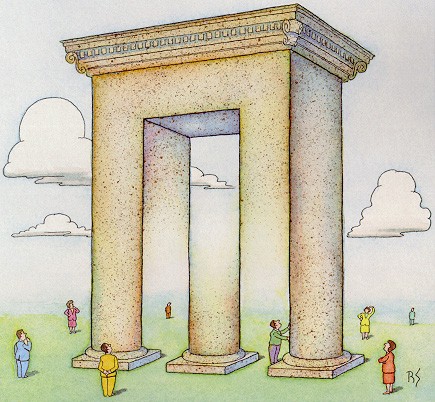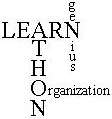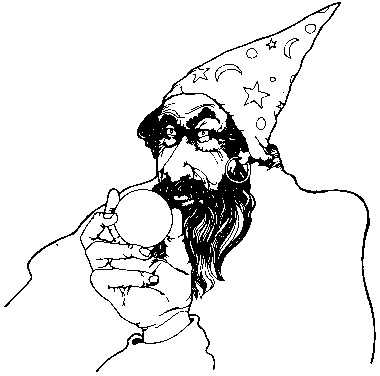Creativity and Innovation

W-503
Fall 2001
BU 400
MBA Section 5476
Thursday 4:00-6:30pm
Prerequisite – MBA Core or permission of professor
Professor W. Harvey Hegarty
Office: BU650
Phone: (812)
855-2580
Email: hegarty@indiana.edu
Web page:
www.bus.indiana.edu/Hegarty/
Office Hours:
T/Th 3-4 pm or email for an appt
Secretary:
Laura Hawkins
Email: lhawkins@indiana.edu
Phone: (812)
855-9200
Course Materials
Michael Michalko, Cracking Creativity: The Secrets of Creative
Genius, 1998, Ten Speed Press, Berkeley, CA ISBN: 0898 159
13X.
Handouts distributed in class.
Materials on reserve.
Course Objectives
· · Help you define useful definitions of creativity and
innovation
· Challenge myths about creativity/creative people that inhibit
your personal explorations
· Develop a perspective of what organizational attributes lead
to a creative/innovative culture
· Learn skills that foster/enhance our capacity to be creative/innovative
· Draw generalizations about how creative/innovative people behave
· Draw generalizations about how creative/innovative groups/organizations
behave
Course Description
The nature of this course will be learning through experience.
There will be a modest amount of reading. There will be a minimum
amount of lecturing. There will be a maximum amount of experiential
learning. Creative/innovative people/organizations are known for
what they produce. Production takes many forms. You can become
more creative/innovative by effectively tapping into your minds’ knowledge
and your life experiences. The course is designed to foster and reward
your production of ideas and perspectives that you here-to-for have not
had.
There will be an emphasis on both quantity and quality.
The two are intimately related. The biggest hurdle you will have
in this course will be saying to yourself, “This won’t work”, “This is
a dumb idea”, “My classmates will really think this is stupid”, “Gee, I
can’t believe what an idiot I am”, “This sucks”,……..the list goes on.
A common thread that characterizes all creative people/organizations is
tolerance for FAILURE.
Example 1. Leonardo da Vinci worked on the Mona Lisa for
decades. He still possessed it when he died. He still was not
satisfied.
Example 2. The post-it note made billions for 3M.
It was a failed product of a research project.
Course Requirements
I. Class attendance AND participation
II. Five-page “paper” discussing a creative person or organization (Your
choice)
III. Home work ----- every week
IV. Group creativity exercise
V. Portfolio. All of your creative efforts during the course and
above and beyond any homework assignments
Participation
Throughout the course we will be in an environment in the classroom
designed for interactive learning. Most of the content of the course
can be gleaned from the assigned book, and the handouts. There will
be a minimal amount of lecturing to supplement this material. A typical
class (and they will all be different) will involve a modest amount of
lecturing, discussion of relevant topical areas, and involvement in various
exercises and simulations which provide some reality to theory and give
you the opportunity to reflect and respond to a variety of situations in
a risk-free environment. For all classes there will be homework assignments
to be completed before class. My philosophy is that the classroom
in a course like this should be a learning laboratory. I don’t consider
this to be my course or your course, but OUR course. In that vein,
I will frequently NOT assume the traditional role of professor – lecturer
and disseminator of information.
Since class only meets once per week, missing class means missing
an entire week. Please email me prior if you MUST miss and why.
Because of the uniqueness of what we sometimes do in class, occasionally
students ask if a spouse or friend can attend class. I welcome visitors,
but would also appreciate email notice.
Individual “Paper”
You will study either a person or an organization of your choosing.
On the last day of class you will have an opportunity to enlighten your
classmates/me on what you found out. The format of your five-page
paper is up to you. Use of prose, diagrams, pictures, references,
websites, laundry lists, etc., etc. are all means by which you can choose
to “produce” a valuable/interesting/creative document.
Group Creative
Experience
Each class will have a creative learning experience(s). I will
take responsibility for the first two. You will be a team member
for one of six others. This will be an opportunity to:
· structure a learning experience
· experience group creativity
· open mind’s to new horizons, perspectives, problem-solving
techniques, etc., etc.
Homework
There will be homework assignments for the first six classes.
This is to be prepared and brought to class. It will be turned in
and returned the following class. We will discuss the homework in
class.
Creative Portfolio
The Creative Portfolio will be your final project (in lieu of an exam)
in the course. It will be a composite of everything you “produced”
during the eight weeks that was above and beyond all the other course requirements.
It does not include all the homework you have already turned in during
the course. It is what you have done in addition to the homework.
It will be evaluated on both quantity and quality. It will also be
assessed as to the variety of activities you engaged in. Unless you
are willing to put in a minimum of two hours per week in building your
portfolio, the likelihood of it receiving a high evaluation is not good.
This will be the crucial determinant in deciding who receives an “excellent”
or a “distinguished” in the course. A second judge will be used to
validate/suggest changes in my evaluations. Just submitting a portfolio
does NOT insure you will get an evaluation of excellent or distinguished
in the course.
MBA Grading Policy
The following grading system has been adopted for both first year core
classes and second year classes. The targeted distribution of grades
in each class is:
Category
Designation |
Reported
Grade |
Targeted
Distribution |
|
|
|
| Distinguished |
A |
10-15% |
| Excellent |
A- |
25-35% |
| High Pass |
B+ |
0-50% |
| Pass |
B |
0-50% |
| Marginal Performance |
B- or C+ |
0-20% |
| Failure |
F |
As Needed |
| Incomplete |
I |
As Needed |
W-503 Grading
Parameters
Pass – come to class, participate, and complete all the assignments.
High pass – the above with some evidence of pushing yourself
to new horizons.
Excellent – the above plus an excellent creative portfolio.
Distinguished – the above plus distinguished creative portfolio.
Compare Parameter
Weighting
| Participation |
20% |
| Individual "Paper" |
20%
|
| Group Creative Experience |
20%
|
| Homework |
20%
|
| Creative Portfolio |
20%
|
| Total |
100%
|
Course Outline
|
Date
|
Questions Addressed
|
Assignment
|
| August 30 |
What will we strive to accomplish in this course? What are your
personal expectations of the course and of yourself?
How do we think? Do you have a “method” for solving problems?
What are paradigms? How do they help us?How do they hinder us?
In what ways has graduate school been enlightening? In what ways
has it been stifling?
|
Michalko 1-18
Creative Experience: Hegarty
Homework assignment given prior to class |
| Sept. 6 |
What are some commonalities of men/women who have been deemed creative?
What are some myths about creativity? How can we grow by overcoming
these myths?
How do we perceive? How can we expand our perceptions?
What are the ways we can use questions to expand our horizons?
Can you find the child inside of you? Why is s/he more creative
than your adult?
What is the cost of only rewarding “adult” behavior?
What values/norms are common in creative/innovative organizations?
|
Michalko 19-80
Creative Experience: Hegarty
Homework assignment given in class |
| Sept. 13 |
How does my “voice of judgment” kill my creative mind?
How can always asking myself questions force me to think beyond the
obvious?
How can improvement be as important as something NEW?
Can force field analysis be a tool I can use forever? |
Michalko 81-112
Group Learning Experience:
Home work assignment given in class
|
| Sept. 20 |
How can I use multiple attributions to paint a geometric picture?
Does looking for “non-sensical” combinations produce produce?
How can random thoughts be combined to yield logical connections?
Will drawing (even though I am NOT an artist) help me discover new perspective? |
Michalko 113-172
Group Creative Experience:
Homework assignment given in class
|
| Sept. 27 |
Can reversing assumptions open closed doors?
What are the merits of working backwards?
What happens when I take “my problem” to a totally new arena?
What keeps groups from being more creative? |
Michalko 173-225
Group Creative Experience:
Homework assignment given in class
|
| October 4 |
What would I do if I could?
What makes you think you can’t?
Why do I REALLY want do this?
What are some alternatives to get what I want/need?
|
Michalko 227-286
Group Creative Experience:
Prepare your “Individual Paper”
|
| October 11 |

|
Individual “Papers” turned in
Group Creative Experience:
|
| October 15 |
Learning
To
Look
Through
New
Windows
Yeilds
Unforeseen
Insights |
Portfolios turned in |
Selected Bibliography
Adams, James, Conceptual Blockbusting, 1986, Perseus Books.
Bacon, Frank & Butler, Thomas, Achieving Planned Innovation, 1973,
The Free Press.
Barker, Joel, Paradigms: The Business of Discovering the Future,
1992, Harper Business.
De Bono, Serious Creativity, 1992, Harper Business.
Brookfield, Stephen, Developing Critical Thinkers, 1987, Jossey-Bass.
Cameron, Julia, The Artist’s Way, A Spiritual Path to Higher Creativity,
1992, Penguin Putnam.
Dennett, Daniel, Kinds of Minds, 1996, Harper Collins Publishing.
Edwards, David, How to Be More Creative, 1979, Occasional Productions.
Ford, Cameron & Giora, Dennis, (Editors), Creative Action in Organizations,
1995, Sage Publications
.
Gardner, Howard, Creating Minds, 1993, Perseus Books.
Glover, John; Roming, Royce & Reynolds, Cecil, (Editors), Handbook
of Creativity, 1989, Plenum Press.
Grudin, Robert, The Grace of Great Things: Creativity and Innovation,
1990, Mariner Books.
Henry, Jane, (Editor), Creative Management, 1991, Sage Publications.
Koestler, Arthur, The Act of Creation, 1964, Penguin Books.
Kuhn, Robert Lawrence, (Editor), Generating Creativity and Innovation
in Large Bureaucracies, 1993, Quorum Books.
MacKenzie, Gordon, Orbiting the Giant Hairball, 1996, Viking Books.
Mattimore, Bryan, 99% Inspiration, 1993, Amacom.
Meehan, Eugene, The Thinking Game, 1988, Chatham House Publishers.
Miller, William, The Creative Edge: Fostering Innovation where
you Work, 1987, Perseus Books.
Mitroff, Ian, Business NOT as Usual, 1987, Jossey-Bass.
Morgan, Gareth, Imagin-I-zation, 1997, Berrett Koehler.
Nadler, Gerald; Hibino, Shozo & Farrell, John, Creative Solution
Finding, 1995, Prima Publishing.
Peters, Tom, The Circle of Innovation, 1999, Oakhill Press Vintage Books.
Ray, Michael & Myers, Rochelle, Creativity in Business, 1989, Doubleday
Publishing.
Ricchiuto, Jack, Collaborative Creativity, 1997.
Shekerjian, Denise, Uncommon Genius: How GREAT Ideas are Born,
1991, Penguin Books.
Silber, Lee, Time Management for the Creative Person, 1998, Three Rivers
Press.
Smilor, Raymond & Kuhn, Robert, (Editors), Corporate Creativity,
1984, Praeger.
Sternerg, Roger, (Editor), Handbook of Creativity, 1999, Cambridge University
Press.
Utterback, James, Mastering the Dynamics of Innovation, 1996, Howard
Business School Press.
von Oech, Roger, A. Whack on the Side of the Head, 1998, Warner Books.
Wallace, Doris & Gruber, Howard, Creative People at Work, 1989,
Oxford University Press.
Weiss, Lynn, A.D.D. and Creativity, 1977, Taylor Publishing.
****Submitted September 10, 2001. Revisions
may be made.****


